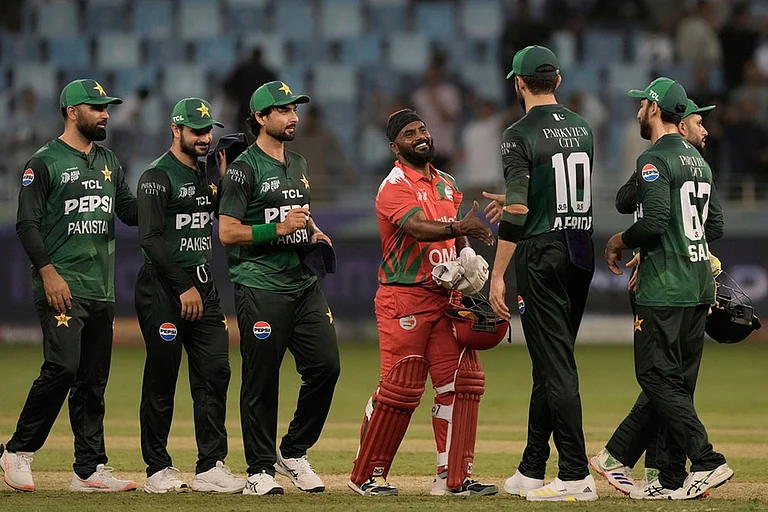Around the same time as the then Prime Minister Chandrashekhar got Assam's regional satrap Prafulla KumarMahanta sacked as Chief Minister on the night of November 27-28, 1990, leading to the clamping of President'srule, the Army's military machine moved into an otherwise sleepy, but dense jungle around Lakhipathar, ineastern Assam's Tinsukia district, 550 KM from Guwahati, the State capital.
That was an assault - codenamed Operation Bajrang - on the general headquarters of the United LiberationFront of Asom (ULFA) located inside that heavily wooded forest. The Operation had been necessitated by thereign of terror that the separatist rebels had created in the State, targeting its tea industry, itsofficials, vital installations and its business and trade. Operation Bajrang was also the firstcounter-insurgency offensive by the authorities against the ULFA, the separatist organization that has soughtto create a 'sovereign, Socialist Assam' since its formation in 1979.
Nearly 13 years down the line, Lakhipathar is again the focus of a major counter-insurgency operation, as Armytroopers from the 2nd Mountain Division once again moved into the area on June 23, 2003. The General OfficerCommanding (GOC) of the Division, Major General H.S. Batra told this writer from his base in the area that alarge number of troops had been deployed to surround the dense forest and track down an ULFA hit-squad thatwas holed up there.
General Batra did not disclose the number of soldiers put into the 'special operation' that has no codename, but several hundred Army men, it is learnt, have been put on the job in the same area that housed theULFA's general headquarters, discovered and smashed in the winter of 1990. Reached by telephone, Brigadier B.K.Gulati, who is directly heading the operation, disclosed that helicopters had been used to scan the forestsand track the movement of the rebels. Till the time of writing on Monday morning, the hunt was still on.
The latest turn of events has raised a number of questions: Is Lakhipathar back on ULFA's map? What could bethe strength of the rebels hiding in this vast forest? Why is the Army undertaking such a majorlocation-specific 'special operation' since normal anti-insurgency offensives have been a continuous processacross the State?
ULFA's military chief Paresh Barua and his aides escaped the 1990 Indian Army 'clean up' because, on thatoccasion, he was at Saraipung, the rebel group's central training camp, and not at the GHQ in Lakhipathar, afour-hour trekking distance away. During the 1990 assault the troops had apparently focused only onLakhipathar and, consequently, came into fire-contact only with the ULFA's '2nd line' leadership.
Today, however, the area is securely in the grip of the Army and other security agencies, and it isunlikely that Lakhipathar could have re-emerged as a safe staging base. Nevertheless, considering the thickforest cover and access to the militant-infested Tirap and Changlang districts in the adjoining State ofArunachal Pradesh, and then on to northern Myanmar, the Upper Dihing Reserve Forest, around Lakhipathar, willalways be a temporary and preferred transit route for ULFA or other rebels.
The GOC of the Army's IV Corps, Lieutenant General Mohinder Singh, who heads the unified operationalcommand of security forces in Assam, has put the number of ULFA rebels currently inside the Lakhipatharjungles at just 30. He told journalists last week that these rebels, from ULFA's '28th battalion' (known tocomprise some of the rebel group's best fighters) had sneaked into the area from their hideouts in Myanmarwith the aim of attacking security forces, and had split themselves into three groups.
In fact, rebels from this 30-member strike force were said to have carried out the night-raid on an OilIndia Limited (OIL) storage facility at Nagajan, near Tinsukia, on June 20, 2003, killing two soldiers of theparamilitary Central Industrial Security Force (CISF), wounding another and losing one of its men in ashootout that followed. The rebels had waylaid a bus carrying OIL personnel to the Nagajan facility on theirway to relieve their colleagues at the end of their work shift. The rebels had also fired a rocket-propelledgrenade at an overhead crude storage tank. Three days later, on June 23, ULFA rebels lying in wait ambushed anArmy column near village Juriapool, close to Lakhipathar. A civilian driver of the hired Army vehicle waskilled, and nine soldiers were injured in that attack.
Counter-insurgency authorities in Assam may have opted for such a 'special operation' primarily with a view todeny ULFA an opportunity to set up even a semi-permanent base in the dense and strategically locatedLakhipathar jungles once again. Besides, the offensive is aimed at either capturing or eliminating the ULFAstrike force, which is armed with RPGs and other weaponry, in view of the latest spurt in their violentactivity. With Independence Day on August 15 approaching, the counter-insurgency authorities are aware thatthe ULFA would try to launch noticeable strikes on security forces or other symbols of state authority as ithas been doing for the past several years now.
The Lakhipathar area acquires additional significance in view of reports that the rebels in six major ULFAbases inside the Himalayan kingdom of Bhutan would try to shift to the Arunachal Pradesh-Myanmar border in theevent of a military crackdown against them by Thimphu (Indian intelligence sources at one stage hadinformation of the existence of as many as 36 camps of the rebel group inside Bhutan).
Already, Army scouts have noticed the existence of huts on the periphery of the Lakhipathar jungles whereULFA men, engaged in hit-and-run strikes or on reconnaissance missions, may have stayed. The areas borderingMyanmar in Arunachal Pradesh would be the next best choice for the large ULFA contingent in case they have tomove out of Southern Bhutan. Access aside, the Myanmar border is under the influence of several northeastIndian rebel groups, including the Khaplang faction of the National Socialist Council of Nagaland (NSCN-K),with which ULFA has a working understanding.
Both Indian and Bhutanese authorities have denied speculations in a section of the media that a militaryoffensive against the ULFA has already begun inside the Kingdom. But, Thimphu had formally set June 30 as thedeadline for the rebels to make a peaceful withdrawal from Bhutanese territory, and had threatened the use of'military force' to expel them if they did not pull out on their own.
With New Delhi commanding tremendous influence over Thimphu, ULFA is not taking the Bhutanese threatlightly. Besides, the Indian Army is known to be in the know of exact details of the locations of ULFA camps,the arsenal at their disposal, their strength and capabilities. It is actually Bhutan's fear of retaliation bythe ULFA on its citizens - who have to pass through Assam territory to reach parts of the landlocked kingdom -that is preventing Thimphu from agreeing to a joint assault with the Indian Army to expel the rebels.
Since the area on the border with Myanmar could be where the ULFA rebels might be looking to shift, lock,stock and barrel if all options were to die out, the counter-insurgency authorities may be trying to step upthe heat to prevent any such attempt. Things on the ground are, however, far from simple, and the outcome ofthe present operations, and developments beyond the June 30 Bhutanese deadline are still entirely in the realmof speculation. .
Wasbir Hussain is Consulting Editor, The Sentinel, Guwahati and Associate Fellow, Institutefor Conflict Management, New Delhi. This article appears courtesy, South Asia Intelligence Review ofthe South Asia Terrorism Portal






















